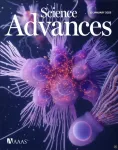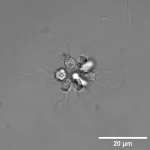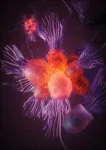(Press-News.org) A new study published in Science Advances reveals evidence of electrical signaling and coordinated behavior in choanoflagellates, the closest living relatives of animals. This elaborate example of cell communication offers key insights into the early evolution of animal multicellularity and nervous systems.
Researchers from the Burkhardt group at the Michael Sars Centre, University of Bergen, uncovered a remarkable diversity of behaviors within the rosette-shaped colonies of the choanoflagellate Salpingoeca rosetta - and the small organisms held even more surprises. “We found communication among the cells of the colonies, which regulates shape and ciliary beating across the rosette,” explains first author Jeffrey Colgren. “We didn’t have clear expectations of what we would see in the cultures before putting them under the microscope, but when we did, it was very exciting.”
Multicellularity is a defining characteristic of all animals, enabling them to interact with their environment in unique ways by integrating the input of highly specialized cell types, such as neurons and muscle cells. For choanoflagellates, flagellated organisms found in marine and aquatic environments all over the globe, the boundary between uni- and multicellularity is less distinct. Some species, including S.rosetta, exhibit complex life cycles that include colonial stages. While the colonies are formed through cell divisions, much like the developing embryos of animals, they lack specialized cell types and are more akin to a group of individual cells than a cohesive organism. "S. rosetta is a powerful model for investigating the emergence of multicellularity during animal evolution”, says last author Pawel Burkhardt. “Since our study reveals that colonial choanoflagellates coordinate their movements through shared signaling pathways, it offers fascinating insights into early sensory-motor systems.”
Using a newly developed genetic tool that enables visualization of calcium activity in S. rosetta, the team found that the cells synchronize their behavior through voltage-gated calcium channels, the same type of channels used by animal neurons and muscle cells. “This evidence of how information flows between cells in choanoflagellate colonies demonstrates cell-cell signaling at the cusp of multicellularity”, says Colgren. Strikingly, the discovery suggests that the ability to coordinate movement at the cellular level predates the first animals.
Moving forward, the team plans to further investigate how signals propagate between cells and whether similar mechanisms exist in other choanoflagellate species. “The tools developed and findings from this study open up a lot of new and interesting questions”,
Colgren concludes. “We're really excited to see where ourselves and others take this in the future.”
END
Tiny microbe colonies communicate to coordinate their behavior
2025-01-08
ELSE PRESS RELEASES FROM THIS DATE:
Researchers develop new technology for sustainable rare earth mining
2025-01-08
Ion-adsorption rare earth deposits (IADs) are primary sources of heavy rare earth elements (HREE), supplying over 90% of the global demand for HREE. However, the current ammonium-salt-based in-situ mining technique has led to severe environmental impacts.
To facilitate sustainable REE mining, Professors ZHU Jianxi and HE Hongping’s team from the Guangzhou Institute of Geochemistry of the Chinese Academy of Sciences (CAS) has developed a green and efficient electrokinetic mining (EKM) technology.
Their work was published in Nature Sustainability on Jan. 6, 2025.
To address the challenges of sustainable and efficient REE extraction, ...
Words activate hidden brain processes shaping emotions, decisions, and behavior
2025-01-08
In an unprecedented new study in the journal Cell Reports, researchers have shown neurotransmitters in the human brain are released during the processing of the emotional content of language, providing new insights into how people interpret the significance of words.
The work, conducted by an international team led by Virginia Tech scientists, offers deeper understanding into how language influences human choices and mental health.
Spearheaded by computational neuroscientist Read Montague, a professor of the Fralin Biomedical Research Institute at VTC and ...
Understanding survival disparities in cancer care: A population-based study on mobility patterns
2025-01-08
A recent study published in Health Data Science, led by Dr. Fengyu Wen from the Institute of Medical Technology at Peking University Health Science Center and Professor Luxia Zhang from the National Institute of Health Data Science at Peking University, reveals significant survival disparities among cancer patients depending on their mobility patterns for medical care.
The study analyzed data from over 20,000 cancer patients in Shandong Province, China, to assess the impact of intra-city, local center, and national center mobility patterns on survival rates. Patients who traveled to local or national healthcare centers had higher five-year survival ...
Common sleep aid may leave behind a dirty brain
2025-01-08
Getting a good night’s sleep is a critical part of our daily biological cycle and is associated with improved brain function, a stronger immune system, and a healthier heart. Conversely, sleep disorders like insomnia and sleep apnea can significantly impact health and quality of life. Poor sleep often precedes the onset of neurodegenerative diseases and is a predictor of early dementia.
New research appearing in the journal Cell describes for the first time the tightly synchronized oscillations in the neurotransmitter norepinephrine, ...
Plant cells gain immune capabilities when it’s time to fight disease
2025-01-08
LA JOLLA (January 8, 2025)—Human bodies defend themselves using a diverse population of immune cells that circulate from one organ to another, responding to everything from cuts to colds to cancer. But plants don’t have this luxury. Because plant cells are immobile, each individual cell is forced to manage its own immunity in addition to its many other responsibilities, like turning sunlight into energy or using that energy to grow. How these multitasking cells accomplish it all—detecting threats, communicating those threats, and ...
Study sheds light on depression in community-dwelling older adults
2025-01-08
January 8, 2025—Marked variation in the prevalence of depression was found in a multisite sample of community-dwelling older adults in the United States reports a study by Columbia University Mailman School of Public Health. Until now, few studies, have examined the frequency of depression in community-dwelling older adults in the U.S. The study is published in the Journal of American Geriatrics Society.
Of the 2,900 participants studied, 6.2 percent had depression. Older adults who had a negative history of depression or had annual household incomes of $50,000 or greater were at significantly decreased ...
Discovery of new class of particles could take quantum mechanics one step further
2025-01-08
PROVIDENCE, R.I. [Brown University] — Amid the many mysteries of quantum physics, subatomic particles don’t always follow the rules of the physical world. They can exist in two places at once, pass through solid barriers and even communicate across vast distances instantaneously. These behaviors may seem impossible, but in the quantum realm, scientists are exploring an array properties once thought impossible.
In a new study, physicists at Brown University have now observed a novel class of quantum particles called fractional excitons, which behave in unexpected ways and could significantly ...
Cost-effectiveness of a polypill for cardiovascular disease prevention in an underserved population
2025-01-08
About The Study: The results of this economic evaluation suggest that cardiovascular polypill treatment (single pill containing a statin and 3 half-standard dose antihypertensives) could be a high value intervention for a low-income, majority Black population with limited access to health care services. It could additionally reduce health disparities.
Corresponding Author: To contact the corresponding author, Ciaran N. Kohli-Lynch, PhD, email ciaran.kohli-lynch@northwestern.edu.
To access the embargoed study: Visit our For The Media ...
Development and validation of a tool to predict onset of mild cognitive impairment and Alzheimer dementia
2025-01-08
About The Study: In this prognostic study, with the use of a statistical modeling approach, the Florey Dementia Index was developed and validated to predict the onset age of mild cognitive impairment and Alzheimer dementia. This tool may be useful in organizing health care for older adults with cognitive decline or dementia and in the future may help prioritize patients for the use of disease-modifying monoclonal antibody drugs.
Corresponding Authors: To contact the corresponding authors, email Yijun Pan, PhD (yijun.pan@unimelb.edu.au) ...
New AI predicts inner workings of cells
2025-01-08
NEW YORK, NY (Jan. 8, 2025)--Using a new artificial intelligence method, researchers at Columbia University Vagelos College of Physicians and Surgeons can accurately predict the activity of genes within any human cell, essentially revealing the cell’s inner mechanisms. The system, described in the current issue of Nature, could transform the way scientists work to understand everything from cancer to genetic diseases.
“Predictive generalizable computational models allow to uncover biological ...




